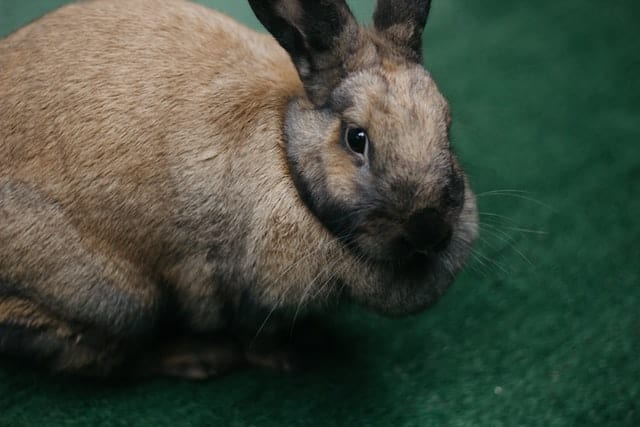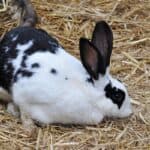
The Giant Flanders rabbit is a very special breed of rabbits. Apart from its exceptional size, as it is one of the largest breeds of rabbits, if not the largest, they have many other peculiarities. Did you know that some of these rabbits can grow to be larger than medium breed dogs?
Before making the decision to buy or adopt a giant rabbit from Flanders, it is important that you know all the details of how to raise giant rabbits. Knowing in depth the character and needs of this breed will help you create an environment conducive to its healthy and happy growth and development.
Origins of the Flanders Giant Rabbit
The Flemish Giant Rabbit is one of the most particular breeds of rabbits. Although today they have become increasingly known worldwide, their fame is relatively recent. Do you want to know more about the origin of this breed? Then keep reading.
The Flanders rabbit is one of the oldest breeds of current rabbits, appearing recorded in documents dating from the 16th century. This giant breed comes from the City of Gent in Belgium, located in the Flanders area, which gives this curious rabbit its name.
Despite being an ancient breed, it was not established as such until the end of the 19th century, specifically in the year 1890. The continental giant rabbit did not gain fame outside Belgium until 1980, it was first brought to England and later to the rest of the world.
Characteristics of the Flemish Giant rabbit
Generally, standard-size breeds do not usually exceed four kilos in weight, while the Flanders rabbit weighs between 6 and 10, and can reach 18 kg! That is a lot of weight for a rabbit, it is the equivalent of a medium-large dog. In addition, there is a difference in weight between males and females, males are usually larger.
It has a very characteristic, broad and large head with a prominent dewlap. Its ears are long and large and are not straight, they are V-shaped. In general, it is a rabbit with quite peculiar characteristics: it has a fairly arched column and a rounded tail.
His hair is straight and of medium length. The colors are very varied, accepting a total of 10, among which the most frequent stand out, for being the most frequent: black, beige, blue, steel gray, white gray and brown.
What is the character of the Giant Dutch rabbit?
Unlike other breeds of rabbits that are active, this cuddly big rabbit is very docile and calm. They do not like to run or jump, but rather they prefer to spend the day lying down resting. This temperament may be due to its large size. Their movements are slow, and they only move to eat and explore the space around them. They like to spend their days lying down and enjoying the calm. That is why they are not suitable for busy and noisy homes. They are very sociable, getting along great with other rabbits, as well as with other pets if they are used to living together. However, they are introverts by nature, which means that a lot of effort has to be put into early socialization for it to be successful.
Necessary care in this breed of rabbits
Having a pet, regardless of the species requires a great commitment on our part. Not only is it enough to give them food, but it is necessary to give them a series of cares that ensure their well-being and happiness.
Like all rabbits, the Flemish giant will need a cage to live in, comfortable and adapted to its size so that it can move freely and not be overwhelmed.
Their diet must be complete, healthy and balanced to cover all your nutritional needs and preserve your good health, preventing obesity and many other diseases.
Remember that rabbits, like other pets, need vaccinations. In addition, you should go to a veterinarian who specializes in exotic animals every time you detect symptoms of illness or unusual behaviour and it is advisable to take him for regular check-ups.
Apart from the basic care of any rabbit, we must pay special attention to the feeding provided to our giant Flanders rabbit. This is because it is easy to fall into the error of thinking that due to their size we have to give them huge amounts of food. And, although they consume greater amounts of food per day than smaller breeds, we must not overdo it, or else they could gain a lot of weight in a very short time, which causes health problems associated with overweight and obesity.
Another factor that differs the most in terms of care with respect to other breeds is the space that your cage or house must have. This space must be large, allowing them to move freely. It is something that we must take into account before adopting one of these rabbits, because if we live in a small apartment, the lack of space can be a problem.
Flemish Giant Health
One of the main health problems that these large rabbits face is obesity, therefore, it is normal for them to fall into the error of giving them excess food due to their large size. But, we have to take into account that they are very sedentary, so they do not have to make a disproportionate intake either. This obesity is dangerous because it carries consequences such as a greater probability of fractures, due to the extra weight that their fragile bones have to bear, joint and cardiovascular problems. You will need to encourage some exercise in your lifestyle to avoid being overweight. Consult with the veterinarian, the recommended amounts of daily food in order to maintain an ideal weight.
We can take advantage of these visits to carry out specific care such as cutting the nails, since if we want to cut the nails of a rabbit at home it can be somewhat complicated.
It is also recommended to keep our rabbit vaccinated and dewormed both internally and externally, as this will prevent a large number of diseases , such as myxomatosis or viral hemorrhagic disease, both fatal in a very high proportion of cases.
Their large size makes them more heat sensitive rabbits, so make sure to keep them at a temperature slightly below 21 ° C and without too much humidity. Their size also makes them more prone to back injuries if they are dropped or handled improperly.
Recommended cage for this species
Finding the right Giant Flanders rabbit cage requires that you first determine whether the rabbit will live inside or outside your home. After this you have to consider the number of rabbits that you intend to have as a pet.
The important thing is that it is a large enough cage so that your rabbit can move freely and safely. We recommend that you keep them out of its cage for as long as possible, so you will motivate them to move and it will also feel more comfortable.
How long does the Giant Flanders rabbit live?
The average lifespan of a Flanders rabbit is 6 to 8 years , however, with a good lifestyle it can live up to 12 years.
Price of the Flanders Giant rabbit
The price of these rabbits for their large size is much higher than that of other breeds of rabbits, hovering between 115.38-173.06 dollars.
How many babies can the giant rabbit have?
The average litter of Flemish giant rabbits is 6 to 10 offspring, however it is not uncommon for a female to give birth to 2 or even up to 21 offspring. Both females and males can become sexually mature within four months.
What is the largest rabbit in the world?
The record is held by ” Darius “, an animal that reaches a meter with a foot and weighs 22 kilos. This rabbit uses a dog house to sleep in instead of the usual cages.






